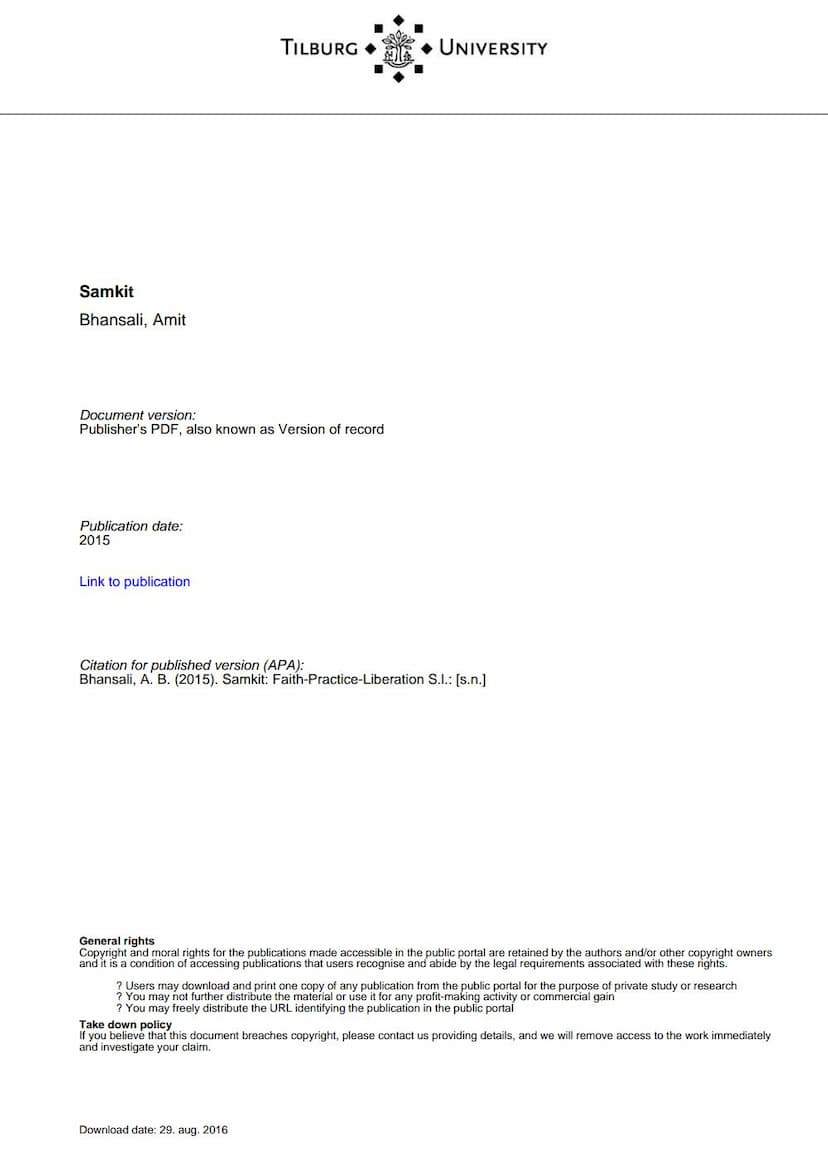Samkit Faith Practice Liberation
Added to library: September 2, 2025

Summary
This document is a detailed academic exploration of "Samyaktva" within Jain philosophy, authored by Amit B. Bhansali. It positions Samyaktva, translated as "enlightened perception" or "right faith," as the foundational principle for spiritual progress and ultimately, liberation (moksha) in Jainism.
The work is structured into three main sections:
Section 1: From Faith to Liberation This extensive section forms the core of the book, delving deeply into the concept of Samyaktva. It begins with preliminary understandings, including invocations (Mangalaacharana) and the definition of Dharma. It then moves to an advanced study of Samyaktva, covering:
- Meaning and Definition: Samyaktva is defined as right perception, knowledge, and conduct, which together form the path to liberation. It is presented as a transformation of perception from "mithyaatva" (false belief) to "samyaktva" (true belief).
- Attributes and Classifications: The book details various attributes and classifications of Samyaktva, including its transcendental (nishchaya) and empirical (vyavahaara) viewpoints. It explores different types of Samyaktva like Saraaga (with attachment) and Viitaraaga (without attachment), Upashama (suppression of karma), Kshayopashama (partial annihilation/suppression of karma), and Kshaayika (complete annihilation of karma).
- Eight Limbs of Samyaktva: These are described as essential qualities for the manifestation of Samyaktva: Nihshankitaa (undoubting faith), Nishkaanshataa (lack of desire for worldly gains from spiritual pursuits), Nirvichikitsaa (lack of revulsion towards ascetics' practices), Amuudhadrishti (correct understanding), Upabrimhana (strengthening faith), Sthirikarana (stabilizing faith in self and others), Vaatsalya (affection for co-religionists), and Prabhaavanaa (spreading the teachings).
- Mithyaatva and the Journey: A significant portion explains Mithyaatva (false belief) as the primary obstacle to Samyaktva and outlines the soul's journey from Mithyaatva towards Samyaktva through various stages of spiritual development (gunasthaanas). The intricate processes like Granthi Bheda (breaking karmic knots), Yathaapravrittikarana, Apurvakarana, and Anivrittikarana are described to illustrate the stages of purification.
- Attainment and Purity: The book discusses the rarity and difficulty of attaining Samyaktva, outlining the necessary preconditions such as being a cognate five-sensed being with the capacity for rational thought. It also details how to protect and purify Samyaktva from its various vitiations (flaws).
- Centrality of Samyaktva: The text emphasizes that Samyaktva is the foundational element for right knowledge and right conduct, making it the most crucial of the three jewels (Ratnatraya) for achieving liberation. Without Samyaktva, other spiritual practices are considered incomplete or even counterproductive.
- Scriptural Basis: The section provides numerous quotes from Svetambara and Digambara Jain scriptures, substantiating the concepts discussed.
Section 2: A Dialogical Interlude This section shifts focus to practical application and interfaith dialogue.
- Dialogical Triangulation: The author explains the methodology used, which involves dialogue and contrasting viewpoints to understand concepts from multiple perspectives.
- Faith and Practice in Religion: An interview with the author explores the practical reconciliation of Jain principles with daily life and business. It highlights the tension between ascetic ideals and householder norms, and how these are managed within the Rosy Blue company.
- Religion Dialogue: This part features interviews with scholars from Buddhism, Christianity, Hinduism, Islam, and Judaism, addressing their perspectives on the soul, faith, and the relationship between faith and practice. This comparative approach aims to place Jainism within a broader religious context.
Section 3: Corporate Social Responsibility: Ideals and Practice This section bridges the gap between religious ideals and their practical application in the business world, using Rosy Blue as a case study.
- CSR in Rosy Blue: The author, as Managing Director of Rosy Blue, details the company's CSR strategy, emphasizing a holistic approach that integrates social and environmental responsibilities with economic prosperity.
- Vision and Commitments: Rosy Blue's vision is presented as balancing economic growth with social and environmental responsibility, guided by core values of integrity, accountability, and diversity. This includes commitments to the UN Global Compact, Responsible Jewellery Council standards, and De Beers' Best Practice Principles.
- Children's Rights: A significant focus is placed on children's rights, driven by the author's personal experiences and the belief that businesses must actively contribute to society beyond mere philanthropy. The book discusses the challenges and importance of integrating children's rights into business operations and supply chains.
- Sustainability Roadmap: The company's journey towards sustainability is outlined, showing the evolution of its CSR strategy and practices over time.
Overall Summary: The book "Samkit: Faith-Practice-Liberation" by Amit B. Bhansali meticulously explores the central Jain concept of Samyaktva, defining it as the foundational right perception crucial for spiritual progress and liberation. It meticulously details its nuances, types, and the path towards its attainment, drawing heavily from Jain scriptures. The work then connects these profound religious and ethical ideals to practical application in the author's own life as a businessman and the CSR strategy of his company, Rosy Blue. Through a dialogical approach and interviews with scholars of various religions, the book offers a unique perspective on how faith and practice can be integrated, and how business ethics can be informed by deeply held religious principles, particularly Jainism's emphasis on non-violence, truthfulness, and detachment. The ultimate message is that Samyaktva is not just a belief system but a transformative art of living that leads to personal purification, spiritual ascent, and ultimately, liberation.